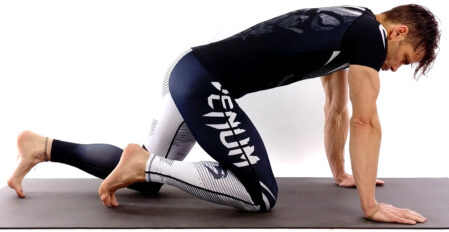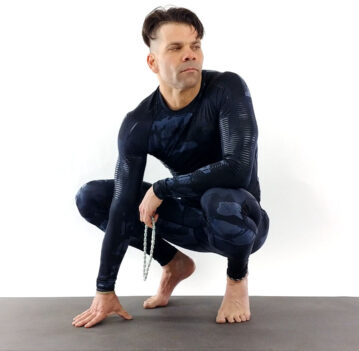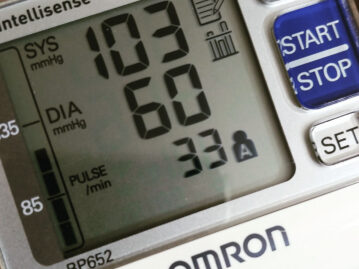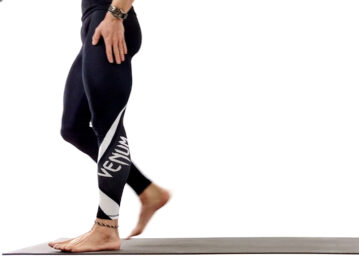Ideal weight was originally defined as that weight in which a person’s longevity was most increased, and mortality most decreased.
Optimal weight is SpineFitYoga’s derivative of ideal weight, where performance on a strength, stamina, and power to weight ratio, as measured by L2 (intermediate level) and L3 (advanced level) of M5 or the MuscleTest.
Hello! Thanks for checking out Spinal Flow Yoga.
This is one of my older “legacy” (2017 and older) blogs from my prior physical therapy site. So if the information you find here seems only moderately related to yoga, or is a bit technical, it’s because I wrote it with a different, but I think still overlapping audience in mind. However, I think each blog does showcase my thought processes and research base, both of which very much influenced what became Spinal Flow Yoga®.
Further, given that spine pain has long been a favorite topic of mine, much of the content within these older blogs will be directly relevant to Spinal Flow® even if at times I criticized yoga. In fact, that’s why I created Spinal Flow Yoga®, to correct what were, and still are, physical problems in modern yoga sequences. Time permitting, I may revisit some of my favorites blogs add some content relating them to newer Spinal Flow® concepts that aim to cure neck and back pain as well as improve overall health and fitness from the comfort of your own home without the need for equipment. Hopefully that will make more sense out of why this blog is here. Click the X or anywhere outside this box to read on.
As I talk about SpineFitYoga, I found myself frequently making reference to ideal weight particularly as SpineFitYoga has morphed from just the best rehab program for back and neck pain in the world (which it certainly is), now to an extremely effective method of overall fitness. Such that some large proportion of new members joining SpineFitYoga don’t have spine pain at all, but are rather using it to get as fit as possible in the most efficient way possible.
What’s more, as I talk about intermittent fasting (IF), particularly with the advent of Protein Sparing Intermittent Fasting (PSIF),once you get the method dialed you can take it pretty much anywhere you want to go. So I figure one might as well aim for perfection. Good questions that then arise are, “what’s perfect weight? how can you tell? perfect for who?” This has been a debate that has gone on for decades at least in the medical literature, for which most academics and professionals have settled on the BMI (Body Mass Index) range of 20-25 or 18.5-25 as healthy. A range for which it seems most people, myself included, find fairly unsatisfying.
Problems I see with BMI
1:
The oft cited complaint is that BMI often lists you as overweight, even if it’s increased muscle mass that has you weighing heavy, which is true sometimes. My complaint, with this complaint, is that it is used to fool oneself about being fat (I know cause I did it) by telling yourself it’s mostly muscle. A look at the heavyweight division in weightlifting and powerlifting shows one can easily have both a lot of muscle, and a lot of artery hardening fat at the same time. While probably not as bad as fat, making the heart pump blood through excessive slabs of muscle might not be the best for longevity either.
2:
BMI is not a target but a broad range, and even so it’s hard enough math to require staring for a long time at a chart, or looking up an online calculator.
3:
BMI is abstract. Hearing your BMI is 27.4 sounds “whatever,” and something you still need to look up to know what it means. Also think it’s better to call fat fat, and if there is some shame (yes, I know I’m pushing pop-psych buttons with use of the word shame) associated with it, good. Use it for motivation to better yourself, which is what shame is for.
4:
People who BMI’s “healthy weight” almost never aim for “dead-center-healthy,” rather they aim for “just-barely-not-fat” with a BMI of 24.9 thinking they’re good. Run the numbers you’ll likely agree that barely “healthy” is usually still kinda chunky.
5:
Generous as BMI is, people, even physicians, still mess it up, at least if my patients are reliable witnesses (admittedly a sketch assumption). One woman told me her doctor said she needs to lose 20 pounds, and I said, “see this chart, you’ll still be obese” at which point she cried. A man said, “my doctor says he wants me at 220 lb, anything less and I’ll look malnourished,” and incredulously I said, “that’s still 30 pounds overweight!” At least he didn’t cry.
I prefer the simple ideal weight formulas popular before BMI became ubiquitous, of which the Hamwi formula, the one I’ll teach, is my favorite.
Reasons to prefer ideal weight
1:
Ideal weight is easy to remember. If I know anyone’s height I can calculate their ideal weight in my head, and probably you can too.
2:
Ideal weight targets to-the-pound, so you A) have only one number to remember and B) know immediately if you are off. I can assure you, being off by a small amount is SO… MUCH… EASIER… to FIX than being off by a large one.
3:
Ideal weight adjusts for sex and frame size, so if you really are big or small boned you can take that into account.
4:
Having worked with the Hamwi formula extensively in relation to SpineFitYoga it seems very close to optimal for both genders. I didn’t want to believe it at first, at least not for guys, you know, cause I’m a guy, and that “mostly muscle” meme owned me for a while.
The ideal weight (Hamwi) formula is thus:
For women ideal weight at 5 feet tall is 100 pounds, and you add 5 pounds for each inch above, or subtract 5 pounds for each inch below 5 feet. Thus a women being 5’4”, ideal weight would be 120 lb. 100 pounds plus 5 lb times 4 inches, equals 120 lb. A woman being 4’11 would be 100 lb, minus 5 lb, equalling 95 lb.
For men 5 feet tall equals 106 lb and you then add 6 pounds per inch above 5’. Thus a man 5’10” would be 106 lb plus 6 lb times 10, equals 166 lb.
Metric? See this paper (page 315) for Hammond’s metric version of Hamwi, otherwise identical, described with a good history of it and other formulas. However, if metric weights and heights were intuitive to me I would use the Broca index, described in the same paper, which is easier still math. Height in cm, minus 100 equals ideal weight in kg. My friend from France says the French (let’s face it, they’re attractive, and live long) use height in cm minus 105 to get their ideal mass in kg, which I think is a really good formula. Most of the ideal weight formulas will get you very close to optimal.
To adjust for bone thickness, or frame size, Hamwi has you adjust ideal weight upwards 10% if you are a large frame, and down 10% if you are a small frame. Frame size in the older literature was done via measuring the width of the elbows, which is a bit impractical to do yourself, but Herring’s book (pg 16) describes measuring wrist circumference, which works well. In my experience the vast majority of people have a medium frame, so I don’t bother going to the tape unless the person’s bones look exceptionally thick or thin. The chart he gave is as follows:
Female: height under 5’2″
- Small boned = wrist size less than 5.5″
- Medium boned = wrist size 5.5″ to 5.75″
- Large boned = wrist size over 5.75″
Female: height between 5’2″ and 5′ 5″
- Small boned = wrist size less than 6″
- Medium boned = wrist size 6″ to 6.25″
- Large boned = wrist size over 6.25″
Female: height over 5′ 5″
- Small boned = wrist size less than 6.25″
- Medium boned = wrist size 6.25″ to 6.5″
- Large boned = wrist size over 6.5″
Male: Height over 5′ 5″
- Small boned = wrist size 5.5″ to 6.5″
- Medium boned = wrist size 6.5″ to 7.5″
- Large boned = wrist size over 7.5″
Better still, Optimal Weight
First off optimal sounds nicer, I mean who doesn’t want to be optimal? Optimal weight has the spirit of something functional, something you make your own, you hone in on, something earned. Whereas ideal is more a rough cut number on a scale, lacking individuality, and still carries the essence of the actuary tables from which it was derived. That said, ideal, is a big clue as to where optimal is, but could also be skinny fat. Thus if your body is far from a razor’s edge, a rough cut file is the tool of choice to get within reach sometime this lifetime. But, once you get to within maybe 3 or 5% of ideal, it becomes less certain which direction you need to go so as to continue increasing relative (to weight) strength, power, and stamina. At that point I’ve found it helps to really listen to your body, and think with regards to what it needs, and how it reacts to inputs, to continue to get stronger. With the bodyweight exercise of M5, if you are losing weight and not improving reps at the same time, that’s a big clue that you are losing muscle. Likewise if you think gaining muscle is what you need, usually a good thought, you’ll know if that’s working because muscle increases reps, fat decreases them, and a combination stays about the same.
My experience
When I was plateauing on my reps, right about ideal weight, which for me is 166 pounds, I had to check myself and think, “what do I need to do to continue to improve? what will further my progress?” Should I weigh a little more, or a little less? Slightly more made PushUps easier but Lunges and PullUps more difficult, so it’s not so simple. Increased leg muscle helps the Lunges, but I have to lift that weight with the PullUps and LoBrids, and likewise with the rest of the routine. The answer always seems to be more muscle, less fat, with balanced muscle development needed everywhere. However, with just 5 minutes of bodyweight training in M5, and the high rep count and speed of L3, “more muscle” and what’s optimal turns out to be much closer to ideal weight than heavyweight, but as I adjust my weight I know, and can feel, that I’m targeting my optimal, not some formula.
And what about the program (M5) itself? What about the diet of IF or psIF? Should I add minutes, reps, sets and exercises to SpineFitYoga, or take them away? Should I eat more or less, calories, protein, carbs, healthy fats. Should I focus on cleaner technique or just go hard? To answer my questions, I tried all of the above. Taking minutes (large chunks and then small) off SpineFitYoga was definitely an improvement, but too far and progress suffered. Turning every exercise of every day into its own, but in a limited time was my best idea, and then I had to hone in on exactly how much time should be given to each exercise, which exercises to keep or discard. In L3 reps and rep speed increased, on some exercises, but paired back on others. The addition of two bonus exercises enhanced the program, breaking some rules, but still fitting within but filling out the 5-minute limit. For meditation and mental strength, 20 minutes at a time tested better than longer or shorter, but I’m still evaluating once vs twice per day. Focus on the breath (concentrative) meditation is certainly better than mantra, or mindfulness for sure.
So what’s my optimal weight? Now it seems 170 lb. or four pounds over “ideal” for me. For the longest time I thought it would be a few pounds below ideal, and at about 3% body fat, I was losing muscle, or at least carbing down instead of losing fat to get lower. I’ll soon be uploading an easy, fast, and inexpensive additional way to self-check body fat at home so stay tuned.





